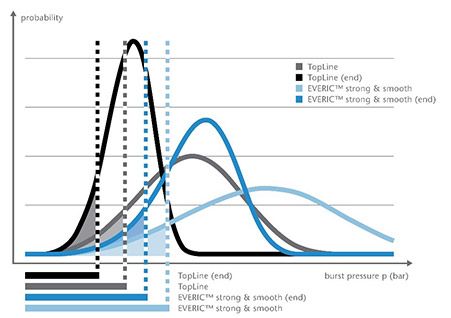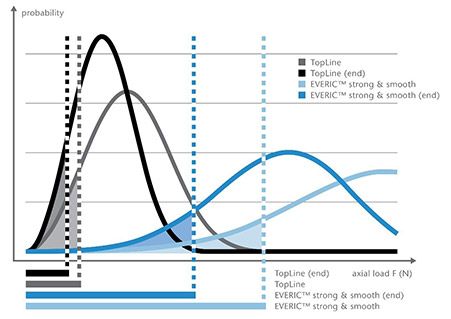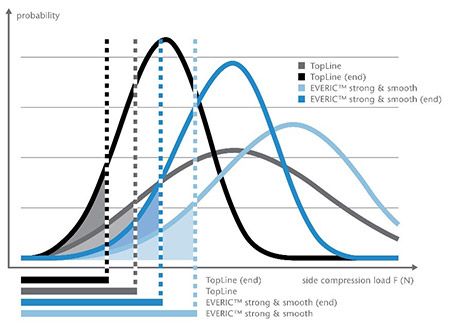Smoothly Through the Production Process
Pharma Insights from Industry Experts | Paid Program
SCHOTT has run a series of line tests to prove the efficacy and efficiency of its modular EVERIC product concepts against vial breakage. The results show a great increase in glass strength. | Sponsored Content
Defects on the glass surface are a major cause of occasional breakage of the primary packaging container during fill and finish or transport. Scratches and cracks are only some of the weak points that can occur to container breakage when mechanical load is applied. With EVERIC™, SCHOTT is introducing a modular concept for different vial features to improve the overall processing performance so that the vials run smoothly on the high-speed bulk production lines. Additionally, it addresses the market trend to individualizing primary packaging container to the requirements of different drug formulations. SCHOTT has run a series of tests to find out more about the glass vials’ tendency to break. The results show a significant increase of vial strength by a factor of 4. At the same time, the tests result in a decrease of cosmetic defects of 95%.
The EVERIC™ concept
The new vial concept offers pharmaceutical companies a choice of features that can be flexibly combined addressing individual needs and requirements in the context of the containers itself and the efficient processing of such a primary packaging. The three respective features are introduced to market by EVERIC™ “pure”, “strong” and “smooth”.
Many pharma companies worldwide already use the first feature, EVERIC™ pure. It addresses the fact that the bottom-near area of vials sometimes tend to have an inhomogeneous surface after the hot forming process, which can lead to delamination or other leached glass elements. This tendency is higher for highly sensitive biotech drugs as they mostly come with a low-filling volume and have an increased risk of reduced drug stability. Dedicated production lines for EVERIC™ pure vials with much tighter in-process control ensures a homogenous wall near the bottom area, the so-called heel zone, and therefore bringing delamination under control. Tests have shown a significant reduction of 68% of sodium at a filling volume of 0.5mL in an EVERIC™ pure vial compared to a standard vial.
EVERIC™ strong and smooth addresses the topic of glass breakage avoidance and efficient processing. The “strong” feature covers an improved geometry within ISO tolerances for these vials. Besides improving the forming process in terms of axial load and side compression, it also leads to an elimination of inherent stress in the glass. Furthermore, the process is optimized at all handling and contact points to offer a flawless glass quality-from to tube to final containers. The “smooth” feature offers an outer coating that additionally protects the outer glass surface from the creation of flaws, (e.g., scratches during the entire process during converting or fill and finish operations. Markus Heinz from Bosch Packaging Technology sees a major benefit in the outer coating: “Scratch resistant vials cause less cosmetic defects and decrease significantly the false reject rate in inspection at later stages of the production process.” The outer coating also creates a low-friction outer glass surface for a smooth container flow in production lines to prevent climbing or sticking and to reduce particles in filling lines.
Vials put to the endurance test
SCHOTT subjects the features “strong” and “smooth” to a series of tests under real conditions. Here, 2R EVERIC™ vials are tested against 2R vials of the highest quality standard currently available from SCHOTT. The tests are undertaken with samples from a trial run of more than 100,000 vials for statistical reasons, once their initial state and after the vials had passed the complete filling process. All vials are filled with WFI (water for injection), sealed, and crimped. Afterwards, the vials are subjected to various tests according to ISO specifications: a burst test (i.e., filling of the vials until they burst), and a strength test involving axial and side pressure in which the vials are subjected to pressure from above or the side. The goal is to test the extent to which the improved geometry and the outer coating makes the vials more resistant to mechanical loads during the filling process. In order to prevent previous damages on the vials, the samples have been delivered in special trays to avoid glass-to-glass contact.
Since only statistical statements can be made within the framework of strength analyses of glass, the results of the tests were presented using Weibull distributions. In Figures 1–3, the X-axis represents the strength of the vial type, while the Y-axis shows the probability of glass breakage occurring. The results concentrate on the 10% quantile of each distribution curve.
Figure 1: The Burst Pressure Test Result

Performing the burst pressure test with the sample vials shows that the EVERIC™ strong and smooth vials can withstand a pressure that is more than 68% higher as the TopLine test vial for the 10% quantile at the end of the fill and finish process.
Figure 2: The Axial Pressure Test Result

The vials that undergo a strength test involving axial pressure demonstrate an increased strength by factor 4 of the EVERIC™ strong and smooth vials compared to the TopLine test vials at the end of the fill and finish process. This test is rather important for efficient sealing and crimping with high pressure (e.g., with press-fit caps).
Figure 3: The Side Compression Test Result

Even the side compression strength testing leads to an increased strength of 63% for the EVERIC™ strong and smooth vials compared to the TopLine test vials at the end of the fill and finish process.
Summary of test results
As a result, the tested EVERIC™ vials show a significantly higher strength than the opponent test sample vials in all three tests both before and after the filling process. This is due to the fact that the vials with their optimized geometry are more stable against mechanical loads from the outset. Furthermore, the additional outer coating effectively reduces mechanically caused damages on the filling line, resulting from glass-to-glass contact with other vials or glass-to-metal contact between the vials and the filling machine. On the other hand, the opponent test vials show damages to the sensitive contact points in the shoulder and heel area as well as in the outer sidewall, which could eventually cause glass breakage. The different curves of each test methods clearly show that all EVERIC™ vials “buffer” mechanical stress on the glass container itself and it can preserve a much higher strength of the glass container at the end of the production process at the pharmaceutical companies.
SCHOTT has optimized the geometry of EVERIC™ strong, specifically the shoulder and heel zones at the upper and lower ends of the sidewall, using computer simulations. This allows the vials to withstand lateral pressure and axial loads much better. The gentle manufacturing process also avoids glass defects to the extent possible from the outset.
During the development of the outer coating for the EVERIC™ vials, SCHOTT placed a great deal of importance on making them abrasion-free and completely transparent. This ensures that the layer does not impair the visual quality controls performed by the pharmaceutical company and that even critical pharmaceutical processes, such as washing and depyrogenation, can be carried out without alteration. The coating not only protects against damages to the glass surface, which can later lead to breakage, but also significantly reduces the particle formation that can occur when pharmaceutical vials rub against each other on the filling lines. Additional tests have shown that the coefficient of friction of coated vials is around 80% lower for vials without a coating.
SCHOTT has taken these positive results to perform further tests on the different features. A different sample of EVERIC™ strong and smooth vials have been tested at a production line of a big pharmaceutical manufacturer. As a result, the quality of the glass containers is maintained throughout the entire fill and finish process with a 95% reduction of cosmetic defects. This leads to a dramatically decrease in production costs for pharma companies.
Is there an optimal strength for pharmaceutical vials?
Some people might ask themselves “why not produce a pharmaceutical vial that is so hard that it prevents defects from occurring in the first place? This raises the question: Is there such a thing as the optimal strength of pharmaceutical vials? In other words, can vials also be too hard? “Our experience suggests that it makes little sense to develop even harder, almost unbreakable glass,” says Markus Heinz, product manager at the machine manufacturer Bosch Packaging Technology. At first glance, this may seem surprising. However, the logic behind it is obvious: whenever a force acts, something has to give way. “A different glass quality can lead, under certain circumstances, to necessary adjustments at the fill and finish machine itself. For example, we are forced to use different materials or process parameters must be adjusted,“ says Holger Palatzky, head of product management from machine manufacturer Bausch+Stroebel.
That’s why SCHOTT takes a different route with its EVERIC™ concept. A flawlessly manufactured glass vial is strong enough to withstand all processing steps. The strength of a glass depends on its weak points, however. If a tensile force acts on a damaged glass surface, it can cause it to break. Defects such as scratches, cracks, or flaking occur during the life cycle, especially during transport or on the filling line. From this definition, one can conclude that, if it is possible to keep the surface of the glass flawless, then the high natural breaking strength of the glass will be maintained and at the same time the machine protected. As this is difficult to achieve in actual practice, vials with product properties such as EVERIC™ strong and smooth can offer a viable alternative to conventional glass vials.